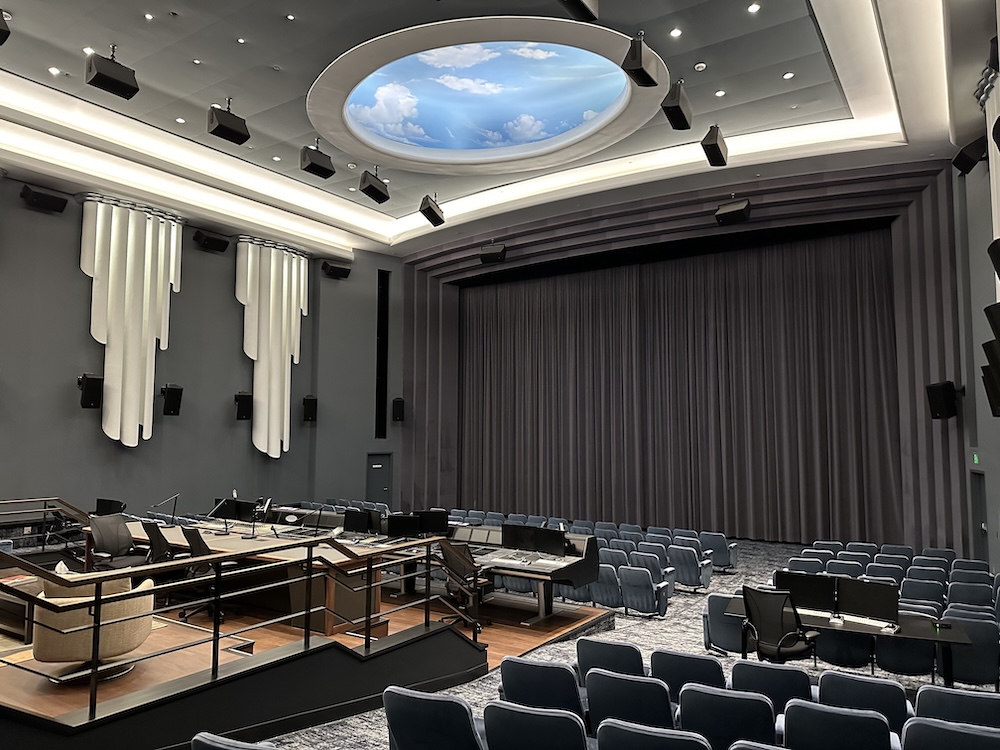-
 play_arrow
play_arrow
Clubalicious Clubalicious Radio
-
 play_arrow
play_arrow
London Calling Podcast Yana Bolder

Culver City, CA (September 25, 2024)—Sony Pictures Entertainment in Culver City, Calif., has long promoted itself as the ultimate destination for postproduction services, offering an environment where creative talent can thrive. To that end, the in-house post-production services team has always had a strong technology game, complemented by an equally strong and detailoriented approach to client amenities.
When Kimberly Jimenez joined SPE in October 2018 as SVP, Post Production Services, there were two re-recording stages outfitted for Dolby Atmos work—the William Holden Theater, which added immersive playback in 2014, and the Kim Novak which did the same two years later. But, checking the schedule, she realized that there were three Atmos mixes coming up. “You know, I’m pretty good at math,” laughs Jimenez, who followed her father, a sound supervisor, into the business, working at NBC Universal, Soundelux and Todd-AO prior to Sony. She alerted Tom “Tommy” McCarthy, EVP, post production facilities (who retired in 2022 after 32 years at SPE), and the in-house team got to work upgrading the flagship Cary Grant Theater for Atmos recording and playback.
Mix Sound For Film Adds Four Hot New Panels
“It was a very quick turnaround,” she recalls. “We were very fortunate to have good people in place to get that done—and the following year, utilization of that stage went up by close to 40 percent.” With that level of success, and the ever-growing demand for immersive mixes and deliverables, it was a relatively easy sell to get all the other stages put onto an upgrade schedule. The last mix stage to receive an Atmos upgrade, the Anthony Quinn, was completed in April of this year. [All of the theatrical stages also support IMAX mixing; two can additionally handle Auro- 3D projects.]
When Lane Burch, executive director of engineering, Post Production Services, returned to the lot in 2018 for his second stint in Sony’s sound department, the Holden and Novak had already been equipped for Atmos. He was tasked with upgrading the rest. Of course, technology is constantly evolving, so while some of the stages were awaiting Atmos upgrades, other stages were being outfitted with newer JBL 5742 fourway ScreenArray speakers.
“The Quinn was an Atmos upgrade and a screen-channel-array upgrade; the Quinn and the Holden were the last to get that screen array,” Burch reports. “We’ve now converted all the theatrical stages to this JBL four-way system, because I want everything to translate well and be standardized across all our rooms.”
Further, Avid S6 mixing systems can now be found across all the stages. A couple of sections of the previous Harrison MPC consoles are still available, and Harrison technology remains at the core of all the rooms. “IKIS [control software] is still very much in play,” Burch notes, “and all signal routing is handled through the X-Router.”

FILM MEETS STREAMING
Since the advent of broadcast television, there has been a delineation between the processes for feature film and TV mixing, but with the rapid rise of premium cable and streaming content, Jimenez says, that line is now so blurred as to have essentially disappeared. “We just finished a very high-end series in what would have traditionally been a feature stage, the Quinn,” she says. “We’re going to be doing another high-end series in the Lancaster, which, again, would be traditionally considered a feature stage. Almost all our mix stages now have theatrical capability, so if we need to do a feature in what would traditionally be a broadcast stage, we have that flexibility as well.”
That’s very intentional. “We want to make it as seamless as possible and have that compatibility not just technically, but sonically,” she explains. “I’m biased, but I think our engineering team is one of the best in the industry. They’ve done a tremendous job making sure that there is consistency in the sound of the rooms.”
During major technical upgrades, Burch and his team will also collaborate with Gredel Berrios, executive director, Sound Facilities Ops and Client Services, to implement improvements to the client amenities and freshen up each room’s aesthetics. “We remove everything—the console, the theater seats—and make the room as bare as possible,” Burch explains. “Then they come in with their scaffolding and have a nice clean palette to paint on.”
SEE THE SONY FACILITIES YOURSELF AT MIX SOUND FOR FILM & TV
In the Quinn, he adds, “The client seating floor area was not ideal, and at the same time, the console was too far back in the room, so we moved the console forward six feet,” he says, to better replicate today’s trend for smaller movie theaters. “It gave us a better client seating area, with a new work surface credenza for them.”
The Quinn posed an acoustical challenge, reports Burch, who consulted with acoustician Peter Grueneisen of nonzeroarchitecture on the upgrade. The room, built about 20 years ago, has a Japanese garden theme with depictions of cherry tree blossoms on the walls and domed ceiling. The problem is, they are oil on canvas; meanwhile, sometime in the past, acoustic shades had been installed to reduce the reflections, and have essentially been left in place ever since. Burch wanted to restore the room to its original look.
The solution was to install Meyer Sound’s patented Libra sound absorption panels, the manufacturer’s first passive acoustical system. “They came in and took high-resolution photos of the artwork and transferred those onto fabric,” he reports. “We left the original artwork on the walls and built the Libra panels out a few inches from those. Standing in the room, you can’t tell the difference.”

AN ALL-NEW B-CHAIN
For the Dolby Atmos upgrade, the tech team added “rings” of JBL 7212 wall and ceiling speakers throughout the Quinn, powered by QSC amplification. JBL 5628 main subs are complemented by JBL ASB 7118 surround subs.
“Of course, we had to add to the BSS BLU [speaker management system] because there are a lot more channels in the room now,” Burch comments. Every stage refresh is an opportunity to clear the troughs of old analog wiring, he also notes. “Now that it’s primarily Cat 6, it gets very clean and efficient when you get that older stuff out of there.”
With new flooring, carpet and wall treatments, plus a new screen, it was time to put the upgraded Quinn to the test. “After we got the room running and tuned, everything looked good from an analysis standpoint,” Burch says. “The first mix in there was Bad Boys: Ride or Die, and they were extremely happy with the sound. Mission accomplished.”
Meanwhile, it turned out that the Novak needed one small tweak. “Will Files was working on Ghostbusters: Afterlife, throwing in some pretty heavy sound effects,” Burch recalls, “and we found a limitation in our surround channels.” The QSC amps just didn’t have the headroom, he says, so after careful evaluation, the surround channels are now driven by Linea Research amps.
The screen arrays in the Holden, the first stage on the lot to be outfitted for Dolby Atmos, in late 2013, were upgraded shortly before the Quinn. Again, more channels of amplification and BSS BLU processing were added. Cosmetically, two new credenzas were installed, dated countertops were replaced with more timeless materials, new flooring and carpeting were laid and the producer’s booth was spruced up.
“It’s important to have these creature comforts and to make sure that the spaces feel creative,” Jimemez says. “I feel like we’ve done a great job of marrying both comfort and creativity in these rooms, while also upping our game on the technology side.”
Written by: Admin
Similar posts
Recent Posts
- 🎶 New Music: JID, OneRepublic, Morgan Wallen, Post Malone, MarkCutz, Kidd Spin + More!
- Classic Tracks: The Fireballs’ “Sugar Shack”
- Classic Tracks: Arlo Guthrie’s “City of New Orleans”
- Classic Track: k.d. lang’s “Constant Craving”
- Classic Tracks: Waylon Jennings’ “Are You Sure Hank Done It This Way”
Recent Comments
No comments to show.Featured post

Latest posts

🎶 New Music: JID, OneRepublic, Morgan Wallen, Post Malone, MarkCutz, Kidd Spin + More!

Classic Tracks: The Fireballs’ “Sugar Shack”

Classic Tracks: Arlo Guthrie’s “City of New Orleans”

Classic Track: k.d. lang’s “Constant Craving”

Classic Tracks: Waylon Jennings’ “Are You Sure Hank Done It This Way”
Current show
Upcoming shows

Swedish Dance Chart
09:00 - 11:00

Fresh Is Fresh
This Weeks Hottest Releases
11:00 - 16:00
In The Mix
Tony Kay
16:00 - 17:00
Norwegian Dance Chart
Top 40 Hottest Tracks in Norway
17:00 - 19:00
Femme House
Lp giobbi
19:00 - 20:00Chart
Powered by Dee jay promotions visit us








 Invalid license, for more info click here
Invalid license, for more info click here